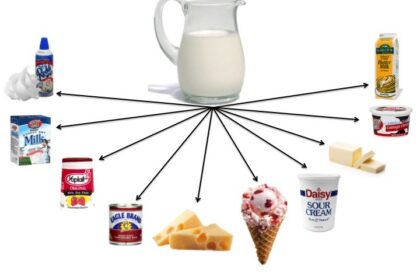
The media articles of Patanjali launching milk products is what brought my interest in this sector …partly because with a smart mix of pricing, distribution and marketing it had broken into even more competitive product categories and had grown into a 10,000 crore company within a period of three to four years.
The first memory I have of milk and milk products is of the milk man cycling in with a big closed aluminium bucket ..He would stop at every home and pour the required amount of milk through a copper tap at the bottom of can and pour it in our vessel…Don’t remember if the money was paid instantly or later on a monthly basis…But the milk guy was a constant every morning and evening…I used to wonder how much cycling he would be doing since he used to go down the slopes at amazing speed… Other products like ghee and stuff used to be made in our home kitchens….though I used to see more of this when I went to my grandmother’s house and there was a goat or cow available at home to take care of the milk requirements…So milk has been a part of everyone’s daily diet from the time I guess and revokes different memories whether from the doodhwala, whether in Milma packets, Amul or the new PET bottles .
This should explain why the milk industry is so big in India…Estimated at close to Rs 5 lac crore annually ..out of which Rs 80,000 crore is in the organised sector. The huge balance is still in the unorganised sector catered to the cycle milk walla in my younger days.
Out of the organised Rs 80,000 crore organised sector Rs 31,000 crores is with AMUL the biggest milk co-operative in India which is present in each and every milk based product category and is targeting Rs 65000 crores by 2021 …
Before we get into that and the market which Patanjali wants to capture lets understand a bit about the milk production in India..
India produces 400 million litres of milk per day..out of which about 160 million litres per day (48 per cent) is retained by the producers for their own consumption. The surplus milk that is available for sale is around 240 million litres per day (52 per cent) and out of that only 70 million litres per day is being used by the organised sector – consisting of co-operatives such as Amul, Mother Dairy (wholly-owned subsidiary of NDDB) and Nandini (a brand owned by the Karnataka Cooperative Milk Producers Federation (KMF), as well as private sector players such as Nestle and Danone. Over 170 million litres of the surplus milk continues to be with the unorganised sector, comprising traditional doodhwalas. In value terms, the Indian milk economy is worth Rs 5 lakh crore, growing at a CAGR of 15-16 per cent, out of which the organised milk economy is worth Rs 80,000 crore.
Over 80 per cent of milk consumption in India is that of liquid milk and over 55 per cent of the revenue of large co-operatives, such as Amul and Nandini, comes from selling liquid milk. There are still limited takers for value-added dairy products such as cheese, yogurts or flavoured milk, but this is where much of the action is taking place today simply because of its higher margins, and the ability to differentiate and introduce new products. Equally, the fact that the milk cooperatives did not tap this market until the multinationals came in…
The top 5 categories and their contribution to the overall organised sector is as below
1)Poly pack milk…………. Rs 36000 cr
2) Ghee…………………… Rs 5500 cr
3) Yogurt/Curd…………… Rs 5200 cr
4) Baby Foods…………… Rs 3000 cr
5) Ice cream……………… Rs 2800 cr
So why is Patanjali entering into this segment and how does it plan to succeed?
· The organised sector caters to only about 25% of the total market. With increasing incomes and smaller and urban families the shift is moving more and more to the organised sector
· India’s per capita consumption of milk at 97 litres a year is way below that of western countries like the US, which boasts per capita consumption of 285 litres per year……and so the potential for growth is immense
· The Indian market is beginning to consume more and more higher value products which increases the scope of value addition and profits
One of the uniqueness of the Indian market is that a major share of the organised sector is controlled by milk co-operatives like Amul where the milk producers themselves are shareholders and the milk is procured directly from the farmers ensuring that middle men are removed and providing good pricing to the actual producers ..Patanjali will also need to follow a similar pattern if it wants to make a dent in this market, the initial launch plan followed by Patanjali is following a similar pattern.
Several big multinationals and international milk companies have earlier tried to break into the Indian market without success. Whether Patanjali is able to make a dent in this market will be seen only in the coming days…



